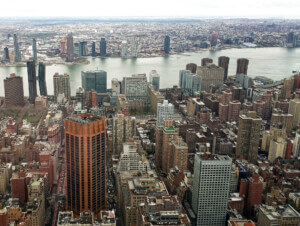In a move viewed as Bill de Blasio’s swan song as New York City mayor, the New York City Council has overwhelmingly approved his administration’s highly contentious SoHo/NoHo Neighborhood Plan. In addition to establishing a major neighborhood arts and culture fund, the historic rezoning will allow for up to 3,500 new housing units—including roughly 900 permanently affordable ones via the city’s Mandatory Inclusionary Housing (MIH) program—across a sizable swath of Lower Manhattan subject to 1970s-era zoning rules that haven’t been substantially altered in over five decades.
December 15’s 43–5 vote by council members comes less than a month after Brooklyn’s similarly controversial Gowanus Neighborhood Plan was approved in a near-unanimous council vote. That 82-block rezoning will allow for 8,500 new housing units to be generated in a (once) largely industrial area flanking what is arguably the most beloved toxic waterway in America, the Gowanus Canal.
The five council members to vote against the SoHo/NoHo rezoning were Inez Barron, Robert Holden, Ben Kallos, Carlos Menchaca, and Kalman Yeger. Menchaca, who represents Brooklyn’s District 38, was also the lone dissenter in the 47–1 vote Gowanus rezoning vote. The SoHo/NoHo Neighborhood Plan was brokered by council members Margaret Chin (District 1) and Carlina Rivera (District 2).
“This rezoning victory sends a powerful message that every community can and should join the fight to help solve our affordable housing crisis and make this city accessible for working families,” said de Blasio in a statement. “SoHo and NoHo are two of the most iconic neighborhoods in the country for a reason – and now, we are one step closer to them finally reflecting all the diversity that makes our city great.”
The boundaries of the 56-block rezoning area are Canal Street to the south, Houston Street and Astor Place to the north, Lafayette Street and the Bowery to the east, and Sixth Avenue and West Broadway to the west.
As detailed by the Mayor’s Office, the revised plan will permit housing and require affordable housing in all new developments on vacant and underutilized land within the impacted area (a largely affluent and predominately white one) while also allowing for the conversion of housing in historically non-residential buildings (with an MIH requirement.) Existing rent-regulated residential units, including those protected by the Loft Law, will remain protected under State tenant protections and supported by a wide range of City resources, per the city.
In addition to the relaxed zoning rules, the approved plan includes the aforementioned SoHo/NoHo Arts Fund, which entails a “future stream of investments” geared to support artists and keep the area’s creative legacy alive; a range of resources that aim to support existing residents; the creation of tools to help preserve the loft-heavy area’s historic character, including height limits and a total ban on towers; retail-focused regulations and investments that aim to bring new life to SoHo and NoHo’s abundance of vacant storefronts and support small businesses and artistic endeavors, and a bevy of investments in neighborhood infrastructure and amenities including a number of public realm and park enhancements. What’s more, the city announced that it will “prioritize the development” of a pair of affordable housing projects at city-owned sites located just outside the rezoning area at 388 Hudson Street and 324 East 5th Street.
This all said, the years-in-the-making rezoning is far from universally beloved and has provoked often fiery debate between backers and opponents. Throughout the process, neighborhood residents and organizations, both grassroots and more established, representing a wide range of interests, have fought tooth-and-nail against the rezoning. Opponents worry that a stampede of real estate developers descending on the area will lead to the ruination of the neighborhood’s distinctive character and that an influx of residential development will induce the displacement of lower-income residents. There has also been skepticism regarding the affordable housing promises. Those rallying against the rezoning essentially claim that it will ultimately result in two adjacent neighborhoods that are less diverse and more expensive than before.
“Everything about this process has been built on deception and sleight of hand,” Andrew Berman, executive director of the Greenwich Village Society For Historic Preservation (Village Preservation), told The New York Daily News.
“Welcome to the future, where huge developer windfalls equals social justice, and building oversized luxury condos, boutique office buildings, overpriced hotels, big-box international chain stores, and NYU dorms, as this plan encourages, is sold as promoting equality,” added Berman in a statement provided to AN. “Today, down officially became up, and night officially became day in New York City.”
Referring to the rezoning as the “SoHo/NoHo/Chinatown Upzoning + Displacement Plan,” Village Preservation noted in a subsequent news release that although it and other groups fought to eradicate or alleviate some of the “worst elements” of the council-approved plan, it remains a “giant giveaway to real estate interests with the promise that a fraction of that will be returned to the public as new affordable housing.”
Contradicting the city’s stated commitment to requiring affordable housing in all new residential developments, Village Preservation said that the plan “still allows vastly oversized development without a single unit of affordable housing to be built,” places an undue burden on rent-regulated tenants, and heaps “added pressure on smaller, locally focused, independent, and arts-related businesses, who will have trouble competing for space with the giant big-box destination retail chains that the rezoning now makes legal throughout the rezoning area.”
In a statement, Moses Gates, vice president for Neighborhood Planning at the nonprofit Regional Plan Association, painted things in a wholly different light: “New affordable housing, especially near jobs and transit, is a critical need for all our neighborhoods. The SoHo/NoHo plan brings exactly that, as well as addressing open space, neighborhood retail, and support for existing tenants and artists. This rezoning shows that with good planning Historic Districts can easily embrace new residents and development, building better places for more people, and that all communities in the region can — and should — look to do the same.”
Mayor De Blasio is expected to sign off on the plan by the end of the year before his final term also concludes.











